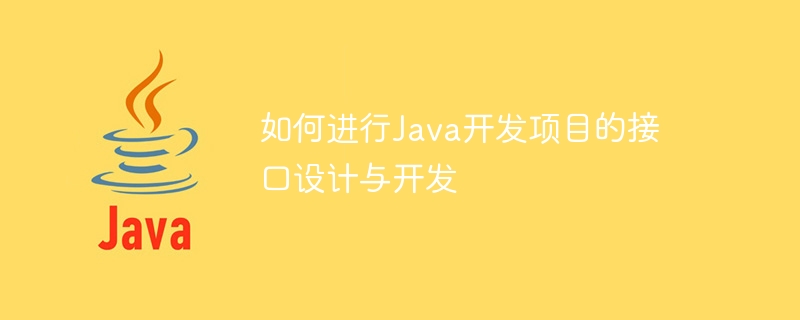

How to carry out interface design and development in Java development projects
In the field of modern software development, interface design and development is a very critical link. Good interface design can improve the maintainability and reusability of code, making teamwork more efficient. Below we will discuss how to design and develop interfaces for Java development projects.
1. Requirements analysis and functional splitting
Before starting interface design and development, we first need to conduct requirements analysis and functional splitting. By analyzing the requirements, the entire system is divided into multiple functional modules and the responsibilities and functions of each module are determined. This allows for a better understanding of the structure and workflow of the entire system.
2. Interface design principles
Interface design needs to follow some basic principles to ensure the ease of use and stability of the interface:
3. Interface design and definition
The design and definition of interface are the core part of interface development. In Java development, an interface is defined by the keyword interface, and the functionality of the interface is declared by defining a method signature. The following is an example:
public interface UserService {
User getUser(String userId);
boolean addUser(User user);
boolean updateUser(User user);
boolean deleteUser(String userId);
}In the above example, UserService is an interface that declares the functions of getting users, adding users, updating users, and deleting users.
4. Interface Implementation and Development
The implementation of the interface is the next step in the interface design. By implementing the interface, we can specifically realize the functions declared in the interface. In Java, interfaces are implemented through the keyword implements. The following is an implementation of the example interface UserService:
public class UserServiceImpl implements UserService {
@Override
public User getUser(String userId) {
// 从数据库中获取用户信息的具体实现
}
@Override
public boolean addUser(User user) {
// 添加用户的具体实现
}
@Override
public boolean updateUser(User user) {
// 更新用户信息的具体实现
}
@Override
public boolean deleteUser(String userId) {
// 删除用户的具体实现
}
}In the above example, the UserServiceImpl class implements the UserService interface and implements the methods in the interface. The specific implementation logic can be based on business needs. customize.
5. Use and testing of interfaces
After completing the design and development of the interface, we can use the interface in other codes. Through the reference of the interface, we can call the methods declared by the interface to achieve decoupling from the specific implementation class. The following is an example of using the interface:
public class Application {
public static void main(String[] args) {
UserService userService = new UserServiceImpl();
User user = userService.getUser("123456");
System.out.println(user);
}
}In the above example, we call the getUser(String userId) method through the reference userService of the UserService interface, and print the obtained user information.
6. Expansion and maintenance of interfaces
When the requirements change or new functions are added, the new requirements can be met through the expansion and maintenance of the interface. In Java, you can add new functional methods by extending the interface, or modify the functional logic by modifying the existing interface. When extending and modifying the interface, care must be taken not to affect existing functions and callers of the interface.
To sum up, interface design and development is a very important part of Java development projects. Good interface design can improve the maintainability and reusability of code, making teamwork more efficient. Through demand analysis and functional splitting, following interface design principles, designing and defining interfaces, implementing interfaces and testing, and extending and maintaining interfaces, we can better carry out interface design and development of Java development projects.
The above is the detailed content of How to carry out interface design and development for Java development projects. For more information, please follow other related articles on the PHP Chinese website!




